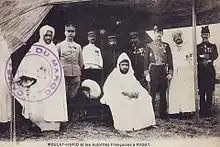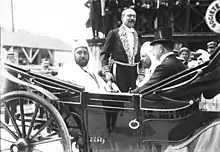Abd al-Hafid of Morocco
Abdelhafid of Morocco (Arabic: عبد الحفيظ بن الحسن العلوي) or Mulai Abdelhafid (24 February 1875, in Fes[2][3] – 4 April 1937, in Enghien-les-Bains)[2][4] (Arabic: عبد الحفيظ) was the Sultan of Morocco from 1908 to 1912 and a member of the Alaouite Dynasty. His younger brother, Abdelaziz of Morocco, preceded him. While Mulai Abdelhafid initially opposed his brother for giving some concessions to foreign powers, he himself became increasingly backed by the French and finally signed the protectorate treaty giving de facto control of the country to France.
| Abd al-Hafid of Morocco عبد الحفيظ بن الحسن العلوي | |
|---|---|
 Portrait taken by J. Giry and given as a gift to Ridder van Rappard, special envoy of the Netherlands, on February 13, 1913[1] | |
| Sultan of Morocco | |
| Reign | 1909 – 30 March 1912 |
| Predecessor | Abdelaziz of Morocco |
| Successor | Vacant until August 1912 Ahmed al-Hiba (in Marrakesh) |
| Born | 1875 Fes, Morocco |
| Died | (aged 62) Enghien-les-Bains, France |
| House | House of Alaoui |
Hafidiya
After his brother Abdelaziz appointed him as caliph of Marrakesh, Abdelhafid sought to have him overthrown by fomenting distrust over Abdelaziz's European ties.[2] Abdelhafid was aided by Madani al-Glaoui, older brother of T'hami, one of the Caids of the Atlas. He was assisted in the training of his troops by Andrew Belton (Kaid), a British officer and veteran of the Second Boer War.[5] For a brief period, Abdelaziz reigned from Rabat while Abdelhafid reigned in Marrakesh and Fes. In 1908 Abdelaziz was defeated in battle. In 1909, Abdelhafid became the recognized leader of Morocco.[2]
Treaty of Fes
.jpg.webp)

In 1911, rebellion broke out against the Sultan. This led to the Agadir Crisis, also known as the Second Moroccan Crisis. These events led Abdelhafid to abdicate after signing the Treaty of Fes on 30 March 1912,[6] which made Morocco a French protectorate.[7] He signed his abdication only when on the quay in Rabat, with the ship that would take him to France already waiting. After an extended visit to France, where he received a great deal of attention from the press,[6] he returned to Morocco and was exiled to the Dar el Makhzen (Sultanate Palace) in Tangier.

His brother Yusef was proclaimed Sultan by the French administration several months later (13 August 1912).[8] Yusef was chosen by some dignitaries of Rabat[8] which wasn't the capital of Morocco at the time.
Despotism
Muhammad al-Kattani, the influential Sufi poet and activist of Fes, was captured, tortured, and beaten to death in front of his wives and children in 1909.[9]
In 1910, Lalla Batoul, a Fesi aristocrat and the wife of a former governor of Fes and supporter of Abdelaziz, was tortured.[10][11] She was chained to the wall in a crucifixion position, completely naked with her breasts seized in a vice, and whipped and interrogated about the whereabouts of her husband's fortune under the direct supervision of Abdelhafid.[10] Walter Burton Harris reported on the incident in an article published in the Times of Morocco.[11][10]
Death
Abd al-Hafid died in Enghien-les-Bains, France, on April 4, 1937.[2] His body was transported to Fez, where he was buried in the royal necropolis of the Moulay Abdallah Mosque.[12]
Honors
- Grand Cross of the Legion d'Honneur of France (1909)
See also
- List of Kings of Morocco
- History of Morocco
References
- "Abdelhafid of Morocco or Mulai Abdelhafid (1875-1937)". 19thcentury-photo. Retrieved 2020-03-20.
- "Abd al-Hafid". Encyclopædia Britannica. I: A-Ak – Bayes (15th ed.). Chicago, IL: Encyclopædia Britannica, Inc. 2010. pp. 14. ISBN 978-1-59339-837-8.
- There is uncertainty about his exact birthdate. Some sources list either 1875 or 1880 without any month or day listed
- Biography of Mulai Abd al Hafiz
- New York Times, November 4, 1908
- W. Harris, "Morocco That Was", ISBN 0-907871-13-5
- Long, David E.; Bernard Reich (2002). The Government and Politics of the Middle East and North Africa. p. 393.
- "Journal Officiel" (PDF). 1 November 1912. Retrieved 22 October 2013.
- Miller, Susan Gilson. (2013). A history of modern Morocco. New York: Cambridge University Press. pp. 67–69. ISBN 978-1-139-62469-5. OCLC 855022840.
- "Supplice de Lalla Batoul : Moulay Hafid au cœur du scandale". Zamane (in French). 2020-04-16. Retrieved 2020-06-22.
- "قصـة الباتـول.. أول معتـقلة سياسيـة في المغرب صلبها السلطان مولاي حفيظ". فبراير.كوم | موقع مغربي إخباري شامل يتجدد على مدار الساعة (in French). 2014-09-24. Retrieved 2020-06-22.
- Bressolette, Henri (2016). A la découverte de Fès. L'Harmattan. ISBN 978-2343090221.
External links
- Morocco Alaoui dynasty
- History of Morocco
- Newspaper clippings about Abd al-Hafid of Morocco in the 20th Century Press Archives of the ZBW
| Preceded by Abdelaziz |
Sultan of Morocco 1908–1912 |
Succeeded by Ahmed al-Hiba |